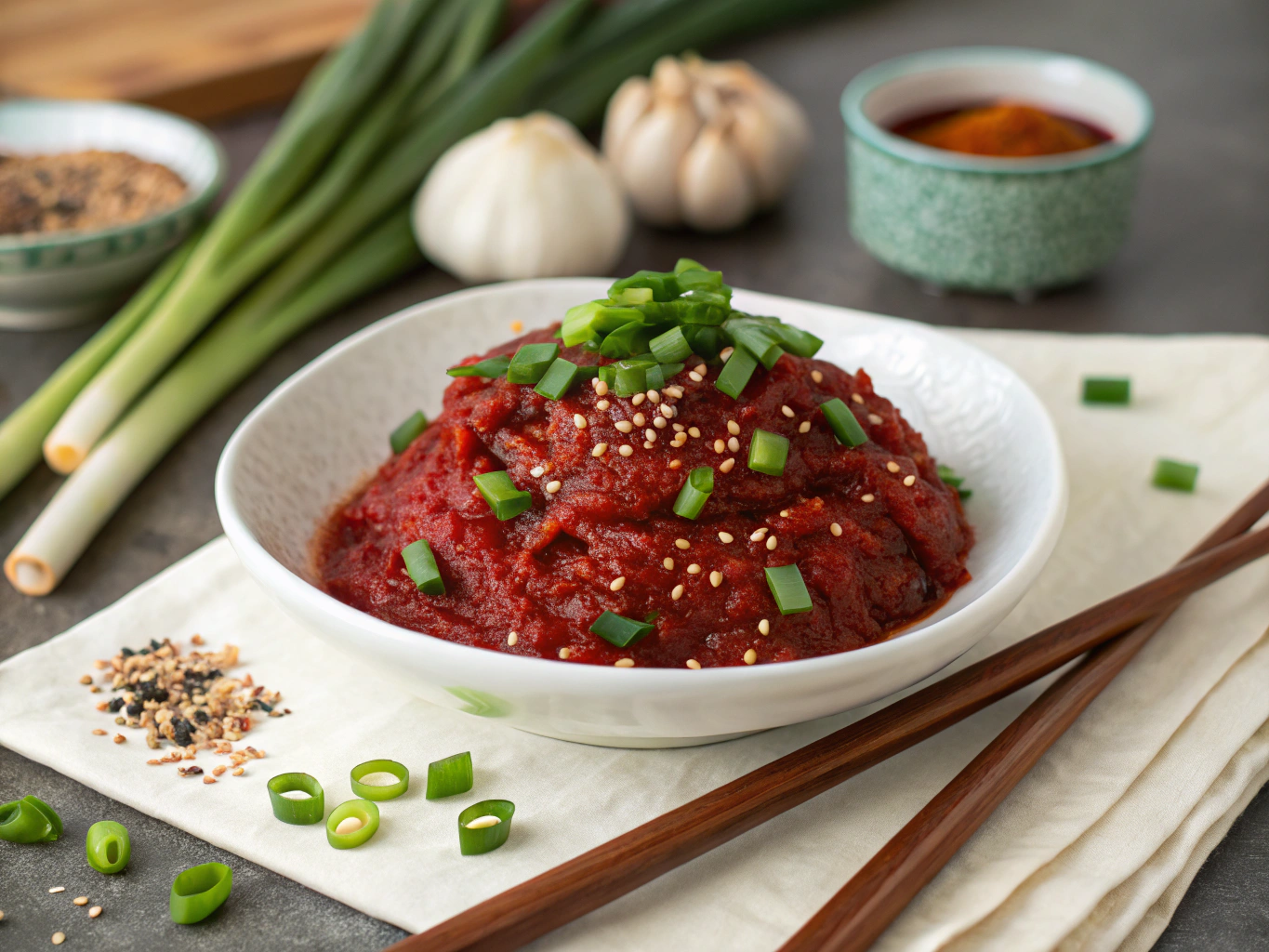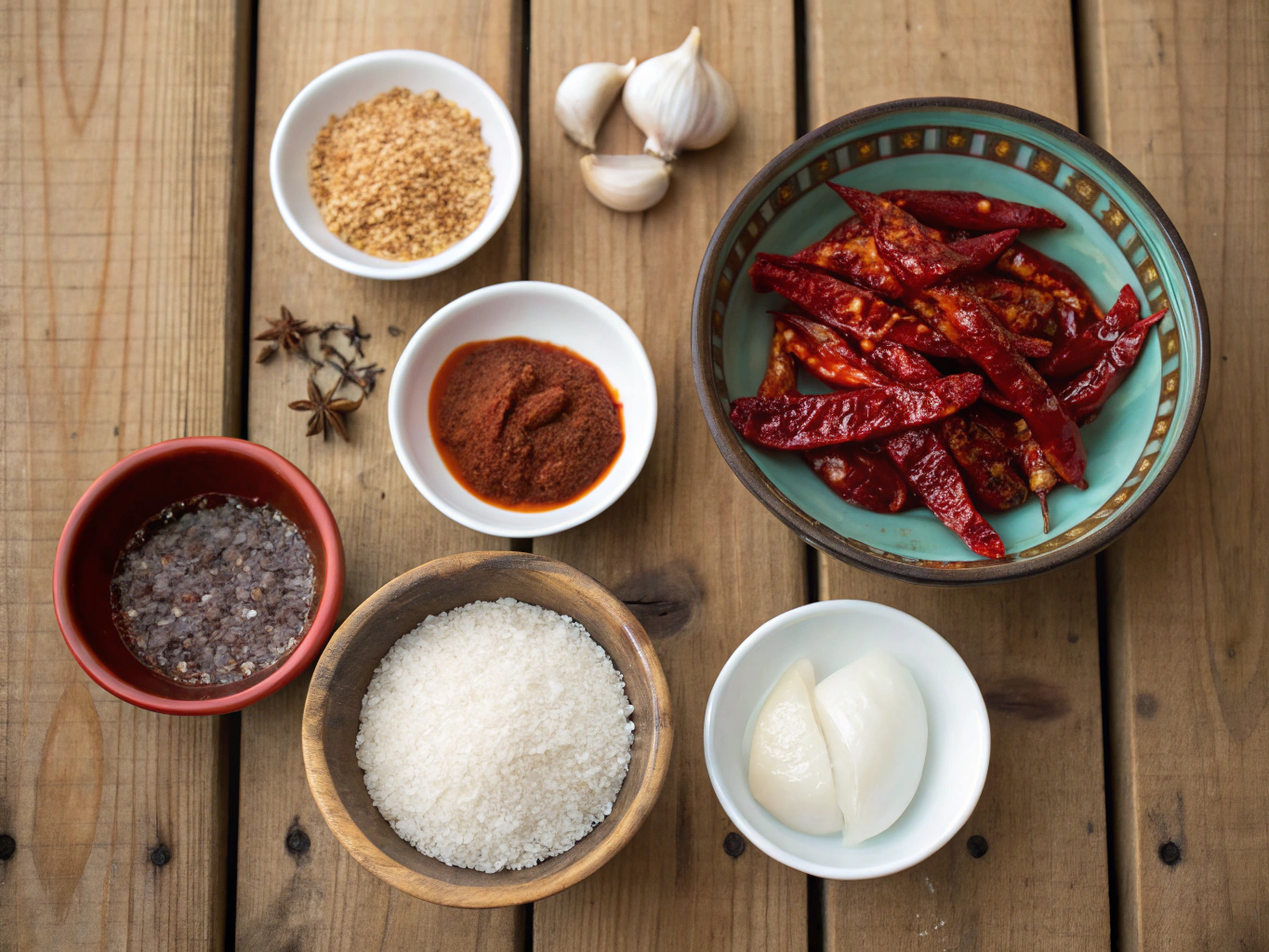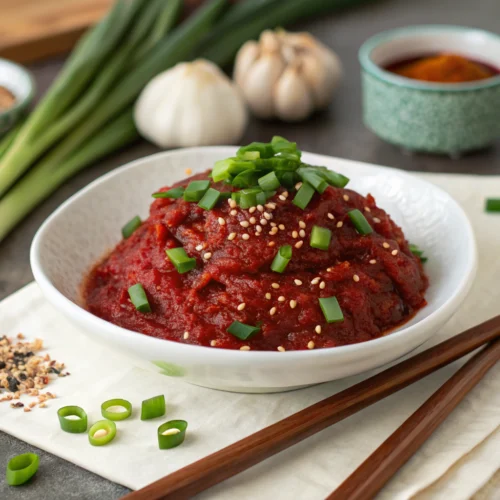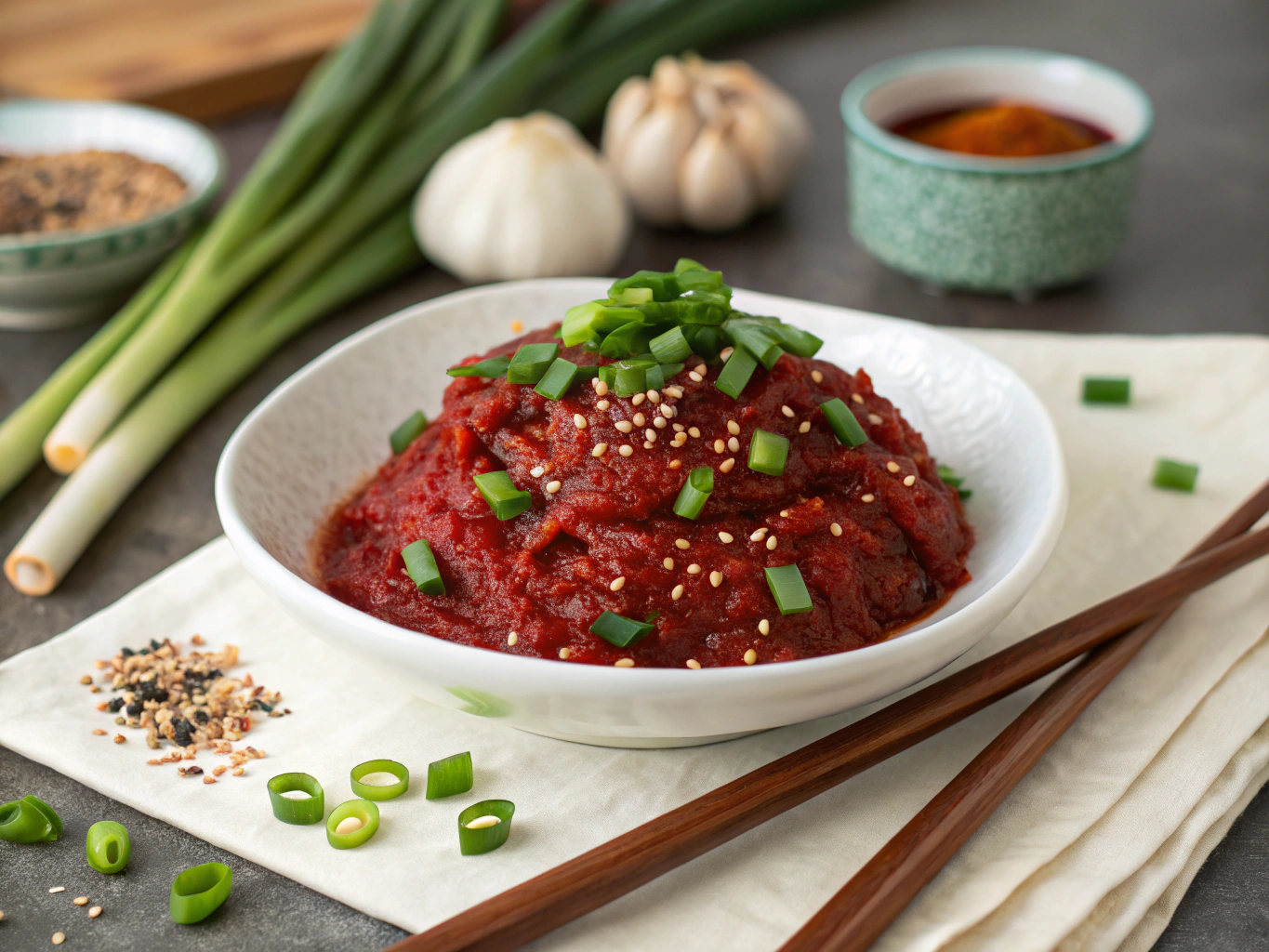
Table of Contents
If you’ve ever tasted a spoonful of gochujang paste, you know it’s not just another chili condiment—it’s a sweet, spicy, umami-packed powerhouse. In today’s post, you’ll learn the story behind this uniquely Korean paste, how I learned to use it in my own kitchen, and how you can start slipping it into everything from marinades to mayo. We’ll dive into what makes gochujang special, break down a simple recipe, explore tasty uses beyond Korean BBQ, and wrap up with expert answers to your biggest gochujang questions.
My Charleston Story Meets Korean Heat
Cooking with Tradition and a Twist
One rainy Sunday afternoon in Charleston, many years back, I stood in my tiny apartment kitchen, cracking open a crimson tub labeled “gochujang paste.” I’d grabbed it on impulse after a vendor at a farmers’ market waxed poetic about its “complex heat.” At the time, I was experimenting heavily with fusion—mixing Southern classics with global ingredients. I tasted a dab, and it hit me: this wasn’t just spicy; it was smoky and slightly fermented, with rich, sticky depth. It reminded me of how my grandmother’s pimento cheese always had more going on than it let on.
From that day, gochujang paste became my secret weapon. I whisked it into collard glaze, stirred it into shrimp and grits, and even folded it into baked beans for a kick that made people pause mid-bite. It taught me something deeper: that bold, unfamiliar ingredients can still feel like home when mixed with intention.
What Sets Gochujang Paste Apart
Gochujang paste is an essential ingredient in Korean cooking, traditionally crafted from gochugaru (Korean red chili powder), fermented soybeans, glutinous rice, and salt. Its bold umami depth comes from the months-long fermentation process, which develops complex flavors no quick sauce can mimic. That sticky texture makes it ideal for marinades, glazes, and sauces—it clings, caramelizes, and amplifies.
Unlike sriracha or chili crisp, gochujang doesn’t shout; it simmers. It’s what gives Korean dishes like bibimbap or tteokbokki their signature flavor profile: savory, spicy, and just slightly sweet. Today, adventurous cooks use it to elevate everything from burgers to soups.
If you’ve got a tub of gochujang paste and no idea where to begin, start small—then savor the layers as they unfold. Let’s dive in.
A Simple Homemade Gochujang Paste You’ll Love
Ingredients List

Here’s a straightforward DIY-inspired version that you can whip up when store-bought gochujang isn’t available—or if you just enjoy playing with bold, fermented flavors. Note that this makes a simplified, non-fermented version for quick use.
- 1/2 cup Korean chili powder (gochugaru)
- 3 tbsp miso paste (instead of fermented soybean powder)
- 2 tbsp apple cider vinegar
- 1/4 cup glutinous rice syrup (or substitute with honey or brown sugar)
- 2 tsp soy sauce
- 1 tsp sesame oil
- 2 tbsp water (adjust for preferred consistency)
- Pinch of salt
Substitution Notes:
If gochugaru is not available, try aji limo paste for a citrus-hot twist. Miso brings the umami, while alternatives like aji pepper paste contribute regional warmth.
Timing Breakdown
This recipe takes just 15 minutes—perfect for last-minute flavor inspiration. There’s no fermentation needed here, so you get 100% zing with next-to-no wait time.
| Task | Time |
|---|---|
| Prep Ingredients | 5 minutes |
| Mix & Adjust | 10 minutes |
| Total | 15 minutes |
Step-by-Step Instructions
- In a medium mixing bowl, combine miso, chili powder, and glutinous rice syrup.
- Add soy sauce, rice vinegar, sesame oil, and one tablespoon of water.
- Whisk until smooth, adding the rest of the water a little at a time.
- Taste and adjust: more sugar if it’s too fiery, a dash more soy for savoriness.
- Store in a sealed jar in the fridge for up to 1 week.
Tip: If mixing by hand, use the back of the spoon to press against clumps and smooth out the texture. For a silkier blend, toss the mixture in a small food processor.
Looking to use your blend right away? Spoon it over roasted vegetables or fold it into mashed sweet potatoes—it harmonizes beautifully with earthy roots.
Amazing Ways to Use Gochujang Paste in Everyday Cooking
Beyond Korean BBQ
While gochujang paste is a culinary hero in Korean classics, it’s also versatile enough for global infusions. I’ve used it in vegan stews from my plant-based collection and even in Cajun-style sauces like my jambalaya seasoning mix. The key? Let it pair with something fatty, starchy, or grilled to mellow and balance its bite.
Toss it into creamy tomato pasta, brush it onto grilled mushrooms, or stir it through hummus for a devilishly addictive dip. One of my favorites? Gochujang mashed sweet potatoes—mild, velvety, with just enough kick to keep things interesting.
You can also blend it with mayonnaise for a euphoric sandwich spread or dress slaw greens with it for a zesty side that feels genuinely new.
Pairing Gochujang with Other Peppers
If you’re experimenting, go sea-deep with other pepper pastes. For instance, a riff on aji verde sauce with a spoon of gochujang adds smoky muscle to herbal brightness. Alternatively, blend aji pepper sauce into a creamy base, then drizzle gochujang on top as a finishing swirl. The contrast? Magic.
Want to teach your palate the full language of spice? Layer gently. Let gochujang be the bass note—deep, round, always present—even when other spicy players shine.
For a deeper dive into global chili flavor pairings, this research hub on spice fermentation offers a fascinating look at how fermentation shapes complex flavors across cultures.
Tips, Storage & Serving Suggestions for Gochujang Paste
Storing Your Gochujang
Store-bought or homemade, your gochujang paste needs cool, dark fridge space. Seal it tight, and it will keep for up to 3 months. The flavor actually deepens over time, and a tiny bit goes a long way.
Tip: Don’t double dip from your spoon—it can introduce moisture and shorten shelf life.
If you’re batch-making, freeze portions in small silicone molds. Pop one out when needed.
Serving & Flavor Pairing Ideas
Whether you grill, glaze, or dip, gochujang thrives on contrast.
- Sweet: Honey, maple, apples
- Creamy: Greek yogurt, tahini, mayo
- Acidic: Vinegar, citrus, tomato
- Earthy: Mushrooms, sweet potato, beans
Planning a plant-based dinner? Combine gochujang glaze with tender tofu for instant depth. Not sure how to start vegan cooking? My beginner-friendly vegan recipes make nice companions.
Slice it into vinaigrettes, tease it into ramen broth, or stir it gently through roasted peanuts for a next-level snack.
FAQs About Gochujang Paste
What is gochujang paste made of?
Gochujang paste is traditionally made from fermented soybean powder, gochugaru (Korean chili powder), glutinous rice, and salt. Some recipes add barley malt or sweeteners like rice syrup.
What is a substitute for gochujang?
If you need a substitute, try combining red chili flakes, miso paste, and a small amount of sugar. Thai chili paste or even aji pepper paste can mimic some of the fiery-sweet undertones.
Is gochujang very spicy?
Not overwhelmingly so. Its spice is medium-level and often mellow due to its sweet and fermented components. You can control the kick with how much you use.
How do I use gochujang paste?
Use it in marinades, glazes, sauces, soups, and even dips. It’s incredibly flexible—start with a teaspoon and adjust to your desired heat and depth.
Conclusion: Cook Bold, Taste Deeper
From Charleston comfort to Korean dynamite, gochujang paste bridges continents and cravings. It’s bold but balanced, familiar yet surprising—just like the food I love creating. Whether you’re blending it into your mac ’n’ cheese or discovering it for the first time, gochujang offers adventures on a spoon.
And as always, whether it’s your fiftieth batch or your first foray into fermented chili, I’ll be right here at FlavivoRecipes.com to guide you, flavor-first.

Simple Homemade Gochujang Paste
Ingredients
- ½ cup Korean chili powder gochugaru
- 3 tbsp Miso paste white or yellow miso
- 2 tbsp Apple cider vinegar
- ¼ cup Glutinous rice syrup or honey, or brown sugar
- 2 tsp Soy sauce
- 1 tsp Sesame oil
- 2 tbsp Water adjust as needed
- Pinch — Salt
Instructions
- In a medium bowl, combine miso paste, gochugaru, and glutinous rice syrup.
- Add apple cider vinegar, soy sauce, sesame oil, and 1 tbsp water.
- Whisk until smooth, adding the rest of the water gradually to reach your preferred thickness.
- Taste and adjust—add more syrup or honey for sweetness, more soy sauce for savory depth, or more chili powder for heat.
- Transfer to a clean jar, seal, and refrigerate for up to 1 week.
- Use immediately as a marinade, glaze, or mix-in for your favorite dishes.
Notes
- For a silkier blend, use a mini food processor.
- Substitute aji limo or Thai chili paste if you don’t have gochugaru—adjust the sweetness to balance extra heat.
- Always store in an airtight jar to maintain flavor and freshness.
- Try mixing it into mayo, hummus, or mashed sweet potatoes for an instant kick.

